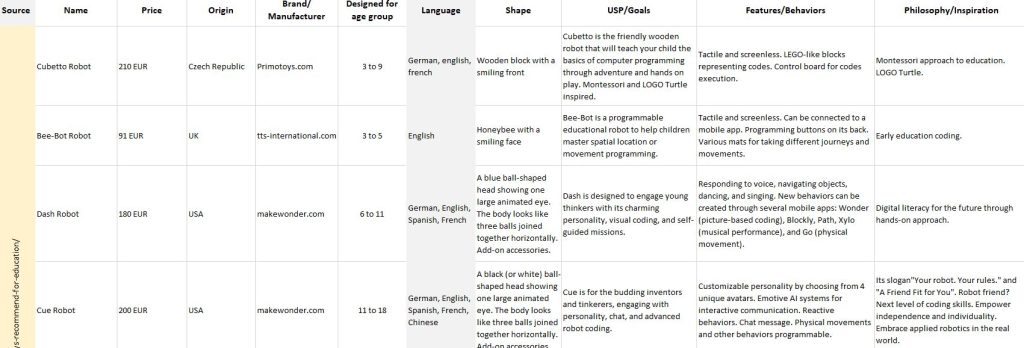What kinds of conversational agents are on the market? Which of them are especially designed for children and how are they called? Prior to this project we already began to look for products which were available on the European markets. We did so only sporadically, although we did find some interesting products. It is only natural to conduct a more systematic exploration in the very first phase of AI-bility project.
The first challenge is to find the most appropriate search terms. We try several word combinations and phrases and find three phrases which give us the results we look for: “smart robots for kids” and “educational robots”. We decide to first search on google shopping, so that we know which products are available in our countries.

We do not stop there. We also look for articles with recommendations for educational robots, companion robots, and smart robots. After reading these recommendations, we realize that some conversational agents for children only have digital embodiments. It means, they are not physical products which we can touch. We can only see them and interact with them on a digital screen.
We collect more than 30 products. The next challenge is to make sense of them. After a long contemplation and several virtual discussions, we create an excel list with some headings. Each heading represents a criterion we consider important in understanding the products. The criteria are name, price, origin, manufacturer, target audience, shape, USP or goals, features or behaviors, and philosophy or inspiration. You see how these criteria are simple and straightforward. This is the descriptive part of our exploration.

Next, we try to interpret our descriptive. This is the analytical and interpretive part of our exploration. We cluster the products based on their similarities and differences. We also read prior research in different disciplines and let our mind wander. We even revisit some textbooks in Philosophy of Technology to get more inspiration. Our curiosity sees no limit and we are always happy to learn. We know that we don’t know. 🙂 One of our favorite researchers is Sherry Turkle. She is the pioneer of studies in human relationship with technology. She has studies both adults and children.
We feel the term “digital companion for children” captures the essence of all products. So, what kinds of digital companions (DC) for children are on the European market? We come up with three clusters:
- Cluster #1: The programmable ones. With these types of DC, children learn how computer systems work by coding them and then watching them in executing simple discreet tasks.
- Cluster #2: Those for leisure and companion purpose. Children are expected to see these DCs as an autonomous entity they can interact with. They can spend their leisure time with these DCs and have fun with them.
- Cluster #3: Those for learning purpose. These DCs are as autonomous as the ones in Cluster #2, except for their purpose. Children are expect to learn “together” with with these DCs.
What’s next? We are currently finalizing our analysis and writing a paper to report on this exploration. Our aim is to present a typology of digital companion for children. With this typology, we hope to spark a scientific interest among information systems researchers to study children’s digital companions even deeper. The typology can also help children and their caregivers to make sense of the market offerings. We will keep you posted on the paper progress.